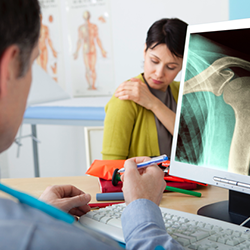Arthritis of the Shoulder

More than 50 million adults in the United States have been diagnosed with some form of arthritis, according to the National Health Interview Survey. The number of people estimated to have doctor-diagnosed arthritis by 2040 is more than 78 million. Arthritis is the number one cause of disability. The most common form of arthritis is osteoarthritis. Arthritis is inflammation of one or more joints such as the shoulder, which causes pain and stiffness. There are two joints in the shoulder, and both may be affected by arthritis.
The acromioclavicular (AC) joint is where the collar bone, clavicle, meets the tip of the shoulder blade, acromion. The glenohumeral joint is where the head of the upper arm bone, humerus, fits into the glenoid cavity of the shoulder blade, scapula. To provide effective treatment, the DOC orthopedic specialists need to determine which joint is affected and the type of arthritis. Five major types of arthritis typically affect the shoulder.
Osteoarthritis is the “wear-and-tear” arthritis that destroys the smooth outer covering, articular cartilage, of bone. Without the cartilage cushion, the bones of the joint rub against each other, causing pain.
Rheumatoid arthritis (RA) is a chronic, autoimmune disease that attacks multiple joints throughout the body. It is symmetrical and usually affects the same joint on both sides of the body. With RA, the immune system attacks its own tissues, cartilage, and ligaments and softens bone.
Posttraumatic arthritis is a form of osteoarthritis that develops after an injury, such as a fracture or dislocation of the shoulder. Rotator cuff tear arthropathy is arthritis that can develop after a large, long-standing rotator cuff tendon tear. The torn rotator cuff cannot hold the head of the arm bone, humerus, in the glenoid socket. The combination of a large rotator cuff tear and advanced arthritis can lead to severe pain, weakness and limited mobility.
Avascular necrosis (AVN) of the shoulder is a painful condition that occurs when the blood supply to the head of the humerus is disrupted. Bones must have a blood supply to survive. AVN can lead to the destruction of the shoulder joint and arthritis. Although there is no cure for arthritis of the shoulder, there are many treatment options available. After discussing symptoms and medical history, the DOC orthopedic specialist will examine the shoulder, checking for weakness, tenderness, range of motion, injuries, crepitus, and pain. X- ray imaging is available at every DOC location to provide detailed images of dense structures, like bone, and to help determine the type of arthritis. As with other arthritic conditions, initial treatment of arthritis of the shoulder is nonsurgical: rest, physical therapy, anti-inflammatory medications, and corticosteroid injections. If pain persists, the condition causes disability and is not relieved with nonsurgical options, shoulder surgery may be warranted, partial, total or reverse total arthroplasty. One or both the head of the humerus and the glenoid are replaced with a metal ball and a plastic cup. If suffering from shoulder arthritis, discuss all treatment options with DOC’s orthopedic surgeon. For information about other shoulder conditions treated by DOC, visit Shoulder Conditions.
For more information on the cost of care, click here.




